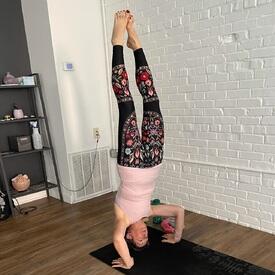You don't use a food scale?
Options
Replies
-
Thank you for sharing, this is the one thing that I know I have to start, waiting for my scale in the mail! I have a question though, how do you all figure out how much of everything you should eat? I struggle with the quantities and figuring out how much of everything I should eat!1
-
Inflammation is the cause of heart disease and blocked arteries and the main dietary drivers of systemic inflammation are the overconsumption of sugars and ultra processed food, aka powdered carbohydrates. Fat doesn't miraculously give us heart disease, even though that is what we've been told ad nauseum for 50 years, overconsumption does, which also leads to complications like heart disease and a briefcase full of other inflammatory diseases. However, I agree with you and if someone is counting calories a scale is mandatory imo. Cheers.0
-
@enopau start by following recommended portion sizes on the nutrition labels for the foods you eat and weighing those out before you eat them so that you know you are only eating as much as you intend to. That also helps you develop a sense of portion sizes for when you eat out (and portions are often oversize and out of your control) Most everything has the portion listed by weight in grams. This is much more accurate than the corresponding measure in teaspoons etc. So, for instance look at the jar of peanut butter and measure out however many grams you think you should eat based on the portion sizes (I generally stick with one, or cut back to 1/2 for very calorie dense foods and how hungry I feel/what else I am eating). If you are just grabbing a snack as you walk through the kitchen put it on the scale first and weigh it and log it so you can keep track of it. That might not be a full portion or it might be some random in between number - doesn’t matter - just keep track. After a few weeks you will see what your eating patterns are and where you can make swaps to replace calorie dense foods, or where you might want to adjust what you eat when in order to feel fuller longer and not want to snack as much if you are going over calories consistently. These are all personal decisions - what and how much of each thing to eat to feel full and happy with your lifestyle, but weighing and keeping track of what you are eating gives you accurate information about how many calories and macros you are consuming so you can make choices based on that info and your particular tastes and needs.3
-
Thank you for sharing, this is the one thing that I know I have to start, waiting for my scale in the mail! I have a question though, how do you all figure out how much of everything you should eat? I struggle with the quantities and figuring out how much of everything I should eat!
I agree with the approach outlined by @Sinisterbarbie1. One place to start is how much you are already eating. Just weigh everything so you're informed how much it is. As you log what you eat, you will find out how that compares with the goals you set. If it turns out you are eating more than your goal, cut back. You ca also track the nutrients in your foods and focus on those that not only fuel your body but support it nutritionally.
I echo that the scale is way more accurate (and precise) than measuring cups. Measuring cups and spoons actually vary quite a bit in size. A gram is a gram - it is how much a milliliter of water weighs.
Here's a trick lots of us use especially for calorie-dense things like nut butters: Remove the lid from the jar, put the jar on the scale, and tare the scale so it reads zero. Then get the knife and remove the amount, in grams, that you want to eat. Note that some is still on the knife after you do something like spread it on bread. You weighed it already, so it's fine to eat it!
When I use cooking oil, I do the same thing. I put the bottle on the scale without the lid, and then I pour some into the fry pan and put the bottle back on the scale. I am amazed how good I am getting at eyeballing eleven grams. Note though that most oils are listed in the database in milliliters. There's a conversion, but you're still WAY ahead if you just use grams.
It may take a while to get used to it, and at first it may seem like a chore. Well, it is a chore sort of, but so is eating. Soon it will become habit and it will become really easy. Use the scale for everything. You will begin to calibrate your eye so you can guess when you have to. Don't stop using the scale or your eye will go out of calibration.
I did a test one time. I would keep rolled oats and sunflower seeds at work and mix them with yogurt. I would weigh out my yogurt from a quart or half gallon into smaller cups and leave those in the refrigerator at work. I got good at estimating 50 grams of oats or one ounce (28 grams) of seeds. One day at home, I poured what I thought was 28 grams of seeds in the palm of my hand, just like I do at work. I weighed them. I was within a gram. I thought that was pretty cool. Doing that test helped me keep my eye calibrated.
3 -
Bump
1 -
Consider trying something like the Ninja saucepan. It’s not Teflon but some kind of super hard steel. If you preheat it well, you can brown meats, caramelize onions, even stir fry with no oils.
I’ve got nice Pampered Chef (no idea-honeycomb surface) and TFal (Teflon) skillets that can be used likewise, but the Ninja pan is in a class by itself, and again, no Teflon (yay!) and wipes clean with the swish of a sponge no matter what I’ve , seared, browned or otherwise charred in it. It’s the one I reach for.
We’ve gotten to the point where we seldom buy butter or margarine, and olive oil and even the smallest can of Crisco go rancid well before we’ve made a dent in the jar.
If I do have to use margarine or oil in a recipe, I cut it by 3/4 before adding more and generally find that’s more than adequate.
I made a chicken cassoulet the other day that called for bread crumbs stirred into half a stick of melted butter. I cut that in half, and could easily have gotten away with just a tablespoon, but the recipe was well within our calorie budget anyway, so I “treated us” to two tablespoons. Since it was making six servings anyway, I figured 17 calories wouldn’t make or break us.2 -
Thank you guys for your tips!0
-
I usually use a food scale. No surprise. I've written about it before. It is an extremely useful tool. Sometimes I don't, like if I am away from home. I have written that through the routine use of my scale, I'm better able to estimate when I have to. Here's an example:
I wanted a snack. I decided to have some roasted Oregon hazelnuts. They are so delicious and have protein and healthy fat. I took the lid off the jar I'm storing them in, I put the jar on my food scale, and I got a tare weight. I took the jar and poured some into my palm. I said to myself, "That is twelve grams." I put the jar back on the scale, and guess what? It said 12g.
My eyeball is, for the moment, calibrated. I will keep using the scale to keep my eyeball calibrated.
Ah NUTS!3 -
Bump0
Categories
- All Categories
- 1.4M Health, Wellness and Goals
- 391.3K Introduce Yourself
- 43.4K Getting Started
- 259.6K Health and Weight Loss
- 175.6K Food and Nutrition
- 47.3K Recipes
- 232.3K Fitness and Exercise
- 387 Sleep, Mindfulness and Overall Wellness
- 6.4K Goal: Maintaining Weight
- 8.5K Goal: Gaining Weight and Body Building
- 152.7K Motivation and Support
- 7.8K Challenges
- 1.3K Debate Club
- 96.2K Chit-Chat
- 2.5K Fun and Games
- 3.2K MyFitnessPal Information
- 22 News and Announcements
- 914 Feature Suggestions and Ideas
- 2.3K MyFitnessPal Tech Support Questions




